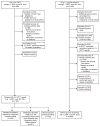Perinatal outcomes associated with the diagnosis of gestational diabetes made by the international association of the diabetes and pregnancy study groups criteria
- PMID: 25162258
- PMCID: PMC4696546
- DOI: 10.1097/AOG.0000000000000412
Perinatal outcomes associated with the diagnosis of gestational diabetes made by the international association of the diabetes and pregnancy study groups criteria
Abstract
Objective: To assess perinatal outcomes with Carpenter-Coustan criteria for gestational diabetes mellitus (GDM), those with normal glucose testing, and those who would be added to GDM by The International Association of the Diabetes and Pregnancy Study Groups (IADPSG) criteria.
Methods: This was a retrospective cohort study of women who underwent screening and diagnostic testing for GDM. Patients were divided into nonoverlapping groups: GDM by Carpenter-Coustan (Carpenter-Coustan), IADPSG GDM criteria but not Carpenter-Coustan (IADPSG), and normal GDM screening or testing (control). Outcomes included newborn birth weight, birth weight z-score, Ponderal Index, and large for gestational age. Data were analyzed with one-way analysis of variance, t tests, or χ.
Results: There were 8,390 women who met inclusion criteria: 338 Carpenter-Coustan; 281 IADPSG; and 7,771 women in the control group. Mean birth weight (3,411 compared with 3,240 g, P<.01), birth weight z-score (0.477 compared with 0.059, P<.01), Ponderal Index (2.79 compared with 2.73 g/cm, P=.014), and large for gestational age (19.9% compared with 8.8%, relative risk 2.25, 95% confidence interval [CI] 1.76-2.88) were higher in IADPSG compared with women in the control group. The IADPSG group had greater birth weight (3,411 compared with 3,288 g, P<.01) than Carpenter-Coustan neonates with no difference in large for gestational age (19.9% compared with 16.0%, relative risk 1.25 95% CI 0.88-1.75), Ponderal Index (2.78 compared with 2.79 g/cm, P=1), or birth weight z-score (0.477 compared with 0.330, P=.30).
Conclusions: Newborns of women who would be added to the diagnosis of GDM by IADPSG criteria have greater measures of fetal overgrowth than those in the control group and greater birth weight in comparison with Carpenter-Coustan GDM neonates.
Level of evidence: II.
Figures


References
-
- Gestational diabetes mellitus. Practice Bulletin No. 137. American College of Obstetricians and Gynecologists. Obstet Gynecol. 2013;122:406–16. - PubMed
-
- Carpenter MW, Coustan DR. Criteria for screening tests for gestational diabetes. Am J Obstet Gynecol. 1982;144:768–73. - PubMed
-
- O’Sullivan JB, Mahan C. Criteria for oral glucose tolerance test in pregnancy. Diabetes. 1964;13:278–85. - PubMed
-
- HAPO Study Cooperative Research Group. Metzger BE, Lowe LP, Dyer AR, Trimble ER, Chaovarindr U, et al. Hyperglycemia and adverse pregnancy outcomes. N Engl J Med. 2008;358:1991–2002. - PubMed
-
- International Association of Diabetes and Pregnancy Study Groups Consensus Panel. Metzger BE, Gabbe SG, Persson B, Buchanan TA, Catalano PA, et al. International Association of Diabetes and Pregnancy Study Groups recommendations on the diagnosis and classification of hyperglycemia in pregnancy. Diabetes Care. 2010;33:676–82. - PMC - PubMed
Publication types
MeSH terms
Substances
Grants and funding
LinkOut - more resources
Full Text Sources
Other Literature Sources
Medical
Research Materials
Miscellaneous

